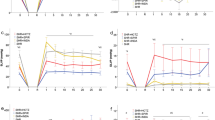Summary
The influence of various drugs and leucocytopenia (induced by cyclosphamid) on isoproterenol (40 mg/kg, s.c.)-induced cardiac necroses was investigated in female SPF Sprague Dawley rats. The influence of fibrinogen reduction was investigated in spontaneously hypertensive rats (SHR). 8–15% of the area of 15 cross-sections were evaluated with a computer-aided morphometric device allowing classification of number and area of necroses. The reduction of number and area of necroses amounted to approximately: 50% by prostacyclin analogue, 25% by S2 inhibition (ketanserin). Inhibition of thromboxane synthesis and fibrinogen reduction from elevated values (200 mg/dl) below the limit of detection by infusion of 35 U/kg Ancrod in SHR had no significant effects, where in SHR only 10 mg/kg isoproterenol were tolerated with a higher extent of necrosis formation.
Leucocytopenia caused a reduction of necroses of over 90%. The condition of mismatch of oxygen consumption and supply induced by high doses of isoproterenol can be considered a model of angina pectoris. The effect of leucocytopenia indicates an essential role of leucocytes in necrosis formation in both situations.
Similar content being viewed by others
References
Bednar M, Smith B, Pinto A, Mullane KM (1985) Neutrophil depletion suppresses 111-In labeled platelet accumulation in infarcted myocardium. J Cardiovasc Pharmacol 7:906–912
Bevilacqua MP, Wheeler ME, Pober JS, Fiers W, Mendrick DL, Cotran RS, Gimbrone MA (1987) Endothelial-dependent mechanisms of leukocyte adhesion-regulation by interleukin-1 and tumor necrosis factor. In: Movat HZ (ed) Leukocyte Emigration and Sequalae. S. Karger AG, Basel, pp 79–93
Blasig IE, Muschick P, Modersohn D, Will-Shahab L, Loewe H (1981) Lactate accumulation and blood flow reduction in rat myocardium after isoproterenol overdosage. In: Szekeres L, Papp JP, Takats I (eds) Pathomechanism and Prevention of Sudden Cardiac Death due to Coronary Insufficiency. International Symposium of the Socialist Countries, Szeged, Hungary, pp 69–77
Blasig IE, Muschenick P, Rohde E, Richter R, Modersohn D, Löwe H (1984) Can blood flow reduction after isoproterenol overdosage induce myocardial ischemia? In: Abhandlungen der Akademie der Wissenschaften der DDR, Abteilung Mathematik-Naturwissenschaften-Technik Jahrgang 1984, Nr. 1N: Cellular and Molecular Aspects of the Regulation of the Heart. Akademie-Verlag, Berlin, pp 243–246
Braquet P, Touqui L, Shen TY, Vargaftig B (1987) Perspectives in platelet-activating factor research. Pharmacological reviews 39:98–135
Bussolini F, Camussi G, Breviario F, Bertocchi F, Ghigo D, Pescarmona GP, Aglietta M, Garbarino G, Bosia A, Dejana E (1988) Endothelial cells and inflammation: the role of plateletactivating factor, interleukin 1, tumor necrosis factor, and circulating neutrophils. In: Braquet P (ed) Platelet-activating factor and cell immunology. Karger, Basel, New trends in lipid mediators research (1), pp 135–143
Engler R (1987) Granulocytes and oxidative injury in myocardial ischemia and reperfusion. Federation Proceedings 46:2395–2396
Haft JJ, Kranz PD, Albert F, Oestreicher R (1973) Protection against epinephrine induced myocardial necroses with clofibrate. Am Heart J 86:805–810
Kammermeier H, Ober M (1985) Essential contribution of thrombocytes to the occuence of catecholamine-induced cardiac necroses. J Mol Cell Cardiol 17:371–376
Kraemer R, Mullane KM (1989) Neutrophils delay functional recovery of the post-hypoxic heart of the rabbit. J Pharmacol Exp Ther 251:620–626
Krawisz JE, Sharon P, Stenson WF (1984) Quantitative assay for acute intestinal inflammation based on myeloperoxidase activity. Assessment of inflammation in rat and hamster models. Gastroenterology 87:1344–1350
Lucchesi BR (1983) Reduction of the extent of ischemic myocardial injury by neutrophil depletion in the dog. Circ 67:1016–1023
Neumann FJ, Waas W, Diehm C, Weiss T, Haupt H-M, Zimmermann R, Tillmanns H, Kuebler W (1990) Activation and decreased deformability of neutrophils after intermittent claudication. Circ 82:922–929
Peres-Polon VL, Correa FMA (1985) Central mechanisms of the isoprenaline-induced hypotension in anesthetized and conscious rats. Gen Pharmacol 15:505–509
Remie R, Knot HJ, Kolker HJ, Zaagsma J (1988) Pronounced facilitation of endogenous noradrenaline release by presynaptic beta-2-adrenoceptors in the vasculature of freely moving rats. N-S Arch Pharmacol 338:215–220
Rona G, Chappel CI, Balazs T, Gaudry R (1957) An infarct-like myocardial lesion and other toxic manifestations produced by isoproterenol in the rat. Arch Path 67:443–455
Schmid-Schönbein H (1977) Microrheology of erythrocytes and thrombocytes, blood viscosity and distribution of blood flow in the microcirculation. In: Altmann WH (et al) (ed) Handbuch der allgemeinen Pathologie. Springer-Verlag, Berlin Heidelberg New York, pp 289–384
Simpson PJ, Fantone JC, Mickelson JK, Gallagher KP, Lucchesi BR (1988) Identification of a time window for therapy to reduce experimental canine myocardial injury: Suppression of neutrophil activation during 72 hours of reperfusion. Circ Res 63:1070–1079
Smith JK, Grisham MB, Granger DN, Korthuis RJ (1989) Free radical defense mechanisms and neutrophil infiltration in postischemic skeletal muscle. Am J Physiol 256:H789–H793
Stewart D, Holtz J, Pohl U, Bassenge E (1987) Balance between endothelium-mediated dilating and direct constricting actions of serotonin on resistance vessels in the isolated rabbit heart. European Journal of Pharmacology 143:131–134
Suzuki K, Ota H, Sasagawa S, Sakatani T, Fujikura T (1983) Assay method for myeloperoxidase in human polymorphonuclear leukocytes. Anal Biochem 132:345–352
Wardlaw AJ, Moqbel R, Kurihara K, Walsh G, Kay AB (1988) Role of PAF in leucocyte activation and chemotaxis. In: Braquet P (ed) The role of platelet-activating factor in immune disorders. Karger, Basel, New Trends in Lipid Mediators Research (2), pp 1–9
Author information
Authors and Affiliations
Additional information
Preliminary results of parts of this study were published in Z. Kardiol. 1987; 83; S1: P 297 and J. Mol. Cell. Cardiol. 1989; 21 S IV: FC 16.
Rights and permissions
About this article
Cite this article
Classen, L., Michalsky, G. & Kammermeier, H. Catecholamine-induced cardiac necroses: Protective effect of leucocytopenia, influence of an S2 antagonist, thromboxanesynthetase inhibitor and prostacycline analogue. Basic Res Cardiol 88, 52–59 (1993). https://doi.org/10.1007/BF00788530
Received:
Accepted:
Issue Date:
DOI: https://doi.org/10.1007/BF00788530



